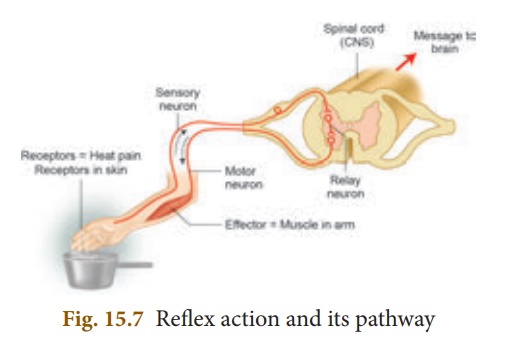Chapter: 10th Science : Chapter 15 : Nervous System
Reflex Action
Reflex
Action
A reflex is any response
that occurs automatically without consciouness. There are two types of
reflexes.
(i) Simple or basic
reflexes:
These reflexes are inbuilt and unlearned responses. Many of the actions
we perform in our day to day life are simple reflexes. e.g., winking of eyes
when any dust particles enters, sneezing, coughing, yawning, etc. We perform
these actions without thinking.
(ii) Acquired or
conditioned reflexes: These reflexes are the result of practice and learning.
Playing harmonium by striking a particular key on seeing a music note is an
example of conditioned reflexes which required conscious training effort. Can
you think of some more examples of conditioned reflexes?
Most of the reflex
actions are monitored and controlled by the spinal cord, hence also known as spinal
reflexes.
The pathway taken by
nerve impulse to accomplish reflex action is called reflex arc. Now, let
us understand how the body executes reflex action when we touch a hot plate.
(i) When we touch a very
hot pan, the stimulus is the heat which is sensed by receptor called as heat
receptors or thermoreceptors in our hand. This stimulus (heat)
inturn triggers an impulse in sensory neuron.

(ii) The sensory neuron transmits or conveys the message to
the spinal cord.
(iii) Spinal cord interprets the stimulus and the impulse
is passed on to the relay neuron which inturn transmits it to a motor neuron.
(iv) Motor neurons carry command from spinal cord to our
arm.
(v) Muscle in our arm contracts and we withdraw our hand
immediately from the pan.
In this example, muscle is an effector organ which has responded to the heat. You will study in higher classes how the neuronal impulse triggers the muscular movement.
Related Topics